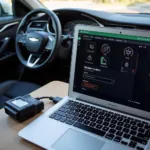Understanding the resistance of your Honda’s fuel injectors is crucial for diagnosing engine performance issues. If you’re troubleshooting with an OBD2 scanner and suspect a fuel injector problem, knowing the correct ohm reading can be very helpful.
Fuel Injectors and Your Honda’s Engine
Fuel injectors are the tiny electronically controlled valves responsible for spraying the precise amount of fuel into your engine’s combustion chamber. Their performance directly impacts your car’s:
- Fuel efficiency: A properly functioning injector delivers the right amount of fuel, maximizing gas mileage.
- Engine performance: Optimal fuel delivery ensures smooth acceleration, consistent power, and minimal emissions.
- Engine lifespan: Accurate fuel metering prevents issues like engine knocking and potential damage from a too-lean or too-rich fuel mixture.
Understanding Fuel Injector Resistance
Fuel injector resistance refers to the opposition to electrical current flow within the injector. It’s measured in ohms (Ω). A faulty injector might have resistance outside the typical range, indicating a problem.
What Should the Resistance of My Honda Fuel Injectors Be?
Generally, Honda fuel injectors should have a resistance between 12 and 16 ohms at room temperature. However, it’s always best to consult your specific Honda model’s service manual for the most accurate information.
Important Note: Temperature can slightly influence resistance readings. If your engine is hot, the resistance might be a bit higher.
How to Test Honda Fuel Injector Resistance
You can test your Honda’s fuel injector resistance using a digital multimeter. Here’s a step-by-step guide:
- Safety First: Disconnect the negative battery cable before working on any electrical components.
- Locate the Fuel Injectors: They’re typically found on the intake manifold, near the cylinder head.
- Disconnect the Injector Connector: Carefully unplug the electrical connector from the fuel injector.
- Set Your Multimeter: Switch your multimeter to the ohms (Ω) setting.
- Connect the Multimeter Probes: Touch the multimeter probes to the metal terminals inside the fuel injector connector.
- Read the Resistance: The multimeter will display the resistance reading in ohms.
- Compare to Specifications: Compare the reading to the manufacturer’s specifications in your Honda service manual.
What If My Honda’s Fuel Injector Resistance Is Out of Range?
If the resistance reading falls outside the specified range, it indicates a potential problem with the fuel injector. This could be due to:
- Open Circuit: An open circuit means there’s a break in the electrical flow, often caused by a broken wire within the injector.
- Short Circuit: A short circuit occurs when electricity finds an unintended path, potentially due to damaged insulation within the injector.
Troubleshooting Tips
- Check Your Connections: Ensure all connections are secure and free of corrosion.
- Inspect for Damage: Look for any physical damage to the fuel injector, wiring, or connector.
- Consult a Professional: If you suspect a faulty fuel injector, it’s best to consult a qualified mechanic for proper diagnosis and repair.
Conclusion
Knowing how to check your Honda fuel injector resistance is a valuable skill for any DIY mechanic. While the standard range is around 12-16 ohms, always refer to your specific Honda model’s service manual for the most accurate information. If you encounter resistance readings outside the specified range, further diagnosis and potential fuel injector replacement may be necessary.


